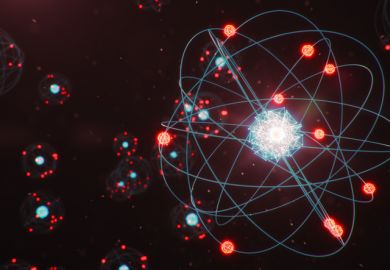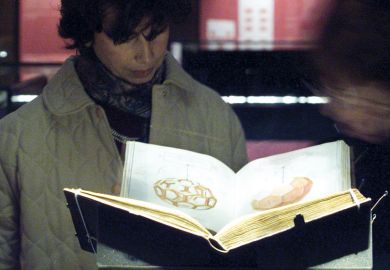February 23, 1987 was a big day for astronomers and physicists around the world. They were astounded and delighted to witness a sight in the sky that had not been seen for more than three centuries. Some 160,000 light years away in our nearest cosmic neighbour, the dwarf galaxy called the Large Magellanic Cloud, a star 20 times as massive as our sun had committed suicide. This giant fusion reactor, held together, like all stars, by a delicate balance between its own gravity and the pressure of the radiation generated in its core, had burnt up all its nuclear fuel in a brief ten million years.
Then, with no pressure to hold it up any longer, it had collapsed inwards within a fraction of a second, compressing its inner core to such high densities that the protons and electrons had been crushed together into neutrons. Through a mechanism not yet fully understood, this had generated a powerful shock wave that had ploughed outwards at supersonic speed through the infalling material and turned around the collapse into a gigantic explosion, Supernova 1987A, that was briefly as bright as the rest of the ten billion stars in the galaxy put together.
Such supernovae had been seen before, on average once every 200 years in our own galaxy. The Chinese have court records of them going back two millennia; a famous supernova in 1054 had been recorded by them as well as the Japanese, the Arabs and the Pueblo Indians - but not in Europe where new stars were not supposed to appear in the immutable Aristotelian heavens. It was only after the Renaissance that astronomers such as Tycho Brahe, in 1572, and Johannes Kepler, in 1604, could announce the appearance of new stars where none had been before.
However, an understanding of what was being seen had to wait until this century when the insights of Fritz Zwicky, Subrahamanyan Chandrasekhar, Robert Oppenheimer, Hans Bethe and others led to the physical picture of stellar collapse sketched above. The most amazing prediction of this model was that 99 per cent of the energy of the supernova should be released not as the radiation that we can see but in the form of neutrinos - particles without any charge (and a tiny mass, if any), which interact so weakly with matter that as John Updike put it: "The earth is just a silly ball/ To them, through which they simply pass/ Like dustmaids down a drafty hall/ Or photons through a sheet of glass". Moreover, unlike the shock wave that takes several hours to work its way to the surface of the star and generate the spectacular fireworks seen at optical wavelengths, the neutrinos escape from the core within a few seconds, thus carrying the first news of the demise of the star to watchers of the skies elsewhere.
This book is by one of the experimental physicists who actually detected a few of these ghostly particles from Supernova 1987A and thereby proved the truth of the remarkable picture that theorists had constructed about the nature of supernovae. This impressive feat required a detector as big as a swimming pool filled with pure water and located a kilometre underground in a mine in Kamioka, Japan, with more than 1,000 sensitive phototubes watching the water for the tell-tale flash caused by a passing neutrino. About five million billion neutrinos passed through the "Kamiokande" of which just 12 underwent scattering and were thus detected. (A similar detector was operating in a saltmine off the coast of Lake Erie in the United States and detected eight events.) These giant experiments had actually been built for a quite different purpose - to test if protons, the constituents of all matter, ultimately decay, as predicted by "grand unified theories" of the fundamental interactions. That quest is still unfulfilled but nevertheless the massive effort put into constructing these detectors has proved rewarding in a way originally unanticipated. Like Galileo's straight man Simplicio in the Dialogue, observers have learnt to look up at the stars while lying on their backs in the ditch.
I would particularly invite all those who hold fashionable postmodernist views on science to read this book to find out why working scientists cannot afford to be cultural relativists. Everyday scientific work, particularly in experimental science, is so hard and tedious, even boring, that no one could possibly do it seriously without believing implicitly that their work may reveal the truth about the physical world. As Mann recounts, much of the actual work in the Kamioka experiment involved trying to control and understand the fluctuating background from residual radioactivity in the water which swamped the signal of interest. Hardly an inspiring activity, yet without it the detector would simply not have been sensitive enough to record extra-terrestrial neutrinos. In fact, this was all realised in retrospect, for the events were not actually recognised when they happened. On hearing that a supernova had been seen in a nearby galaxy, the experimentalists realised that the neutrino burst should have passed through their detector a few hours before the optical sighting and searched back through their computer data tapes to find it. I wonder what the "strong programme" sociologists of science would make of that - was it a valid discovery or was it "constructed"?
Mann gives a clear if somewhat bland account of the basic physics and astronomy necessary to put this discovery in context. His writing style is dry and subdued; apart from a few anecdotes he deliberately avoids communicating the drama and excitement of the enterprise for he says " I this is principally the story of a star and not of the humans who studied it". To me this is rather disappointing, for as a key insider Mann could have perhaps conveyed more about the social dynamics of large scientific collaborations. My other quibble is that as someone not expert in astrophysics and cosmology, Mann should have had his manuscript reviewed more thoroughly. Apart from several incorrect statements (for example, that a closed universe is doomed to expand and contract endlessly), he contributes to the general misunderstanding of the big bang by referring to it repeatedly as an "explosion".
On the whole this book is well worth a read and readers may be inspired to keep an eye on what is happening at the ten times bigger successor to Kamiokande - "Super-Kamiokande" - which began operating recently. Before the silver jubilee of Supernova 1987A comes around, we may well find ourselves witnessing an even more spectacular vision of cosmic birth and death in our own galaxy.
Subir Sarkar is lecturer in theoretical physics, University of Oxford.
Shadow of a Star: The Neutrino Story of Supernova 1987A
Author - Alfred K. Mann
Editor - Sandie Byrne
ISBN - 0 7167 3097 9
Publisher - Freeman
Price - £16.95
Pages - 210



